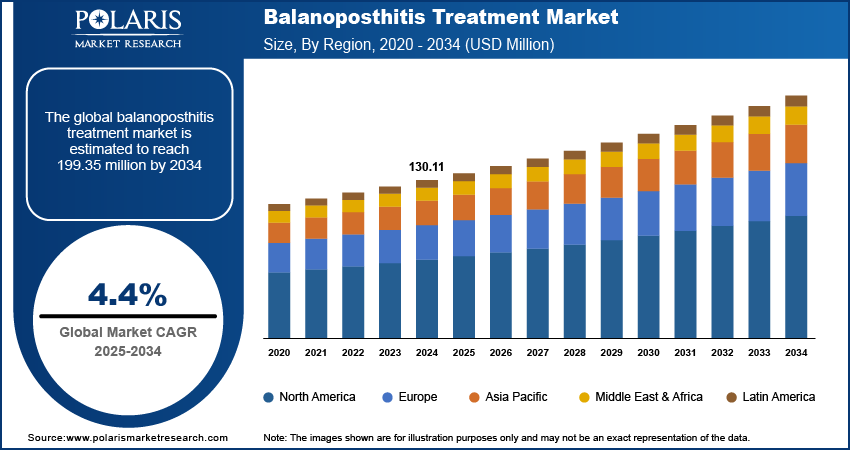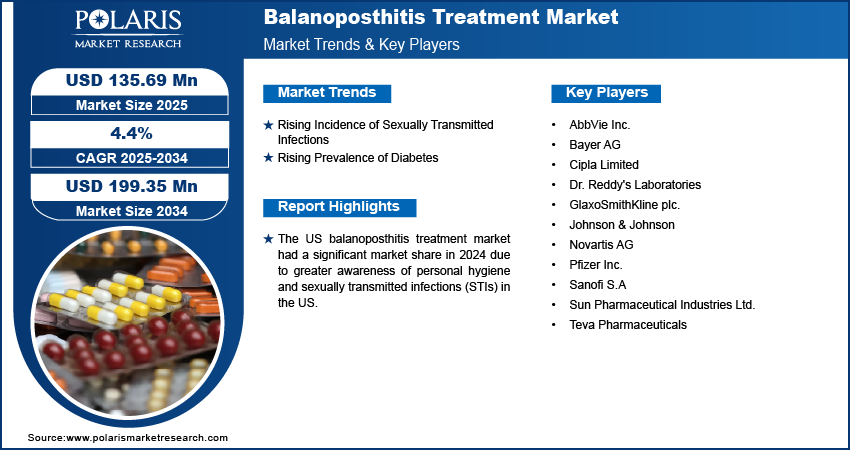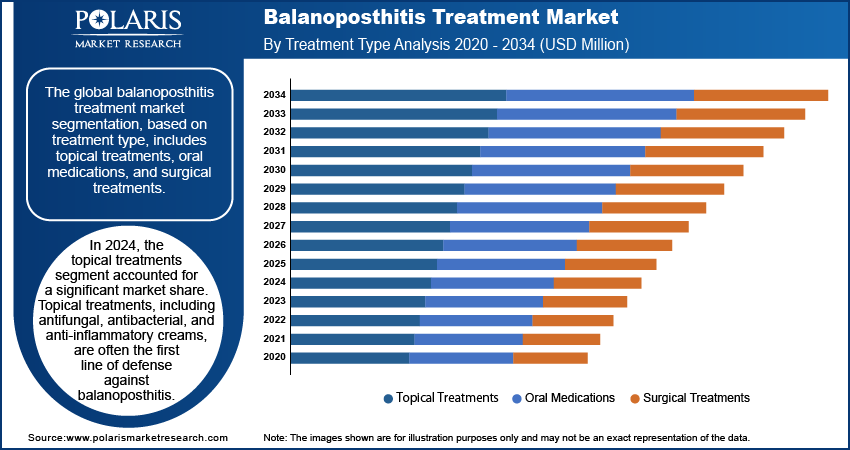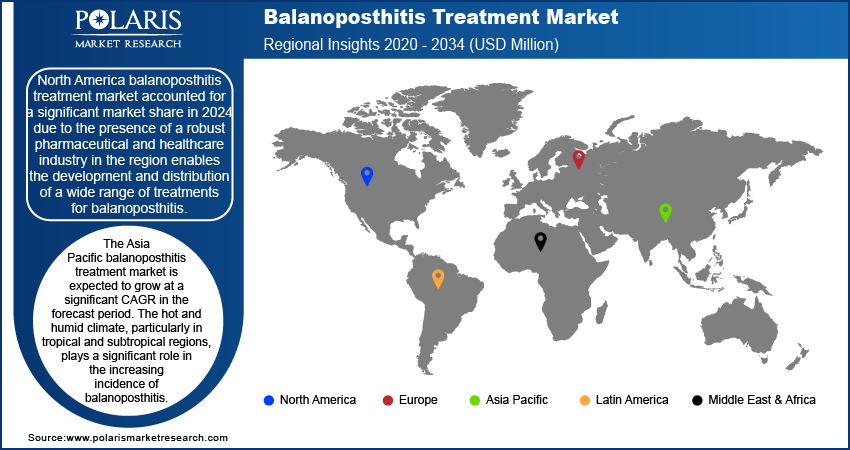
Balanoposthitis Treatment Market Size, Share, Trends, Industry Analysis Report: By Treatment Type (Topical Treatments, Oral Medications, and Surgical Treatments), Distribution Channel, End Use, and Region (North America, Europe, Asia Pacific, Latin America, and Middle East & Africa) – Market Forecast, 2025-2034
- Published Date:Dec-2024
- Pages: 120
- Format: PDF
- Report ID: PM5329
- Base Year: 2024
- Historical Data: 2020-2023
Balanoposthitis Treatment Market Overview
Global balanoposthitis treatment market size was valued at USD 130.11 million in 2024. The market is projected to grow from USD 135.69 million in 2025 to USD 199.35 million by 2034, exhibiting a CAGR of 4.4% during the forecast period.
The balanoposthitis treatment market is defined as the management of balanoposthitis, an inflammatory condition affecting the glans, penis, and foreskin. Etiologies include inadequate hygiene practices, bacterial and fungal infections, allergic reactions, and sexually transmitted infections (STIs). Rising inadequate personal hygiene, particularly among uncircumcised males, leads to the accumulation of smegma, which increases the risk of balanoposthitis, thereby contributing to the market growth. Enhanced awareness of balanoposthitis among healthcare providers and patients has led to more frequent diagnoses, which in turn increases the demand for balanoposthitis treatment. Furthermore, the increasing obesity rate is leading to a higher risk of infections and skin conditions, including those affecting the genital area. Thus, the global rise in obesity is contributing to the increase in balanoposthitis cases, thereby contributing to market growth.

To Understand More About this Research: Request a Free Sample Report
The increasing elderly population, who are more prone to conditions like diabetes and compromised immunity, contributes to the growing demand for balanoposthitis treatments, which in turn increases the market growth. Moreover, advancements in treatment options such as antifungal, antibacterial, and anti-inflammatory medications, including topical creams and systemic treatments, contribute to market growth by offering more effective and targeted therapies.
Balanoposthitis Treatment Market Drivers and Trends
Rising Incidence of Sexually Transmitted Infections
The rising incidence of sexually transmitted infections (STIs) is a critical factor contributing to the increase in balanoposthitis cases. For instance, according to the CDC, in 2022, over 2.5 million cases of syphilis, gonorrhea, and chlamydia were accounted for in United States, highlighting the significant burden of sexually transmitted infections (STIs). Infections such as herpes and chlamydia are particularly concerning as they directly affect the genital area, leading to significant inflammation and infection of the glans and foreskin. These inflammatory responses cause discomfort, which further facilitates the growth of pathogenic microorganisms. The increased frequency of sexually transmitted infections cases drives demand for effective treatment options. Consequently, the rising prevalence of STIs contributes to the growing demand for balanoposthitis treatments, thereby fueling market growth.
Rising Prevalence of Diabetes
The rising prevalence of diabetes is significantly increasing the susceptibility to balanoposthitis among affected populations. For instance, the International Diabetes Federation reported that approximately 537 million people globally were affected with diabetes in 2021, with over 75% of adult cases occurring in low- and middle-income countries. Projections indicate that the number of individuals with diabetes will surge to 643 million by 2030 and 783 million by 2045. Diabetic patients are particularly prone to balanoposthitis due to elevated glucose levels in the urine, which create a conducive environment for yeast infections and other irritations of the foreskin and glans. As a result, the rising global burden of diabetes is fueling the demand for balanoposthitis treatments, thereby driving growth in the balanoposthitis treatment market.

Balanoposthitis Treatment Market Segment Insights
Balanoposthitis Treatment Market Assessment by Treatment Type Outlook
The global balanoposthitis treatment market segmentation, based on treatment type, includes topical treatments, oral medications, and surgical treatments. In 2024, the topical treatments segment accounted for a significant market share. Topical treatments, including antifungal, antibacterial, and anti-inflammatory creams, are often the first line of defense against balanoposthitis due to their direct application to the affected area, which allows for targeted therapy with minimal systemic side effects. These treatments are particularly effective in managing the localized symptoms of balanoposthitis, such as redness, swelling, and discomfort, making them a preferred option for both patients and healthcare providers. Furthermore, continuous advancements in topical formulations, including the development of more potent and fast-acting products, have enhanced their efficacy. These factors have contributed to the significant market share held by the topical treatments segment within the balanoposthitis treatment market in 2024.
Balanoposthitis Treatment Market Evaluation by Distribution Channel Outlook
The global balanoposthitis treatment market segmentation, based on distribution channel, includes hospital pharmacies, retail pharmacies, and online pharmacies due to the increasing consumer preference for the convenience of online shopping, the accessibility of a wide range of products, and the discreet nature of purchasing sensitive treatments through digital platforms. E-pharmacy provide access to an extensive array of balanoposthitis treatments, including both prescription and over-the-counter options. This comprehensive selection enables patients to find specific medications or formulations for the treatment. Thus, the online pharmacies segment is witnessing significant growth over the forecast period.

Regional Insights
By region, the study provides market insights into North America, Europe, the Asia Pacific, Latin America, and the Middle East & Africa. North America balanoposthitis treatment market accounted for a significant market share in 2024 due to the presence of a robust pharmaceutical and healthcare industry in the region enables the development and distribution of a wide range of treatments for balanoposthitis, including topical therapies and antifungal medications. Furthermore, the increasing obesity rate in the region is growing balanoposthitis cases, which require specific treatment. For instance, according to Trust for America's Health, the national adult obesity rate from 2017 to 2020 was 41.9%, with Black and Latino adults exhibiting the highest rates at 49.9% and 45.6%, respectively. Obesity often leads to increased skin folds and moisture retention, creating an environment that fosters bacterial and fungal growth, particularly in areas like the groin. Additionally, it is frequently associated with metabolic disorders such as type 2 diabetes, where elevated blood glucose levels contribute to the development of infections, including balanoposthitis. This heightened susceptibility to balanoposthitis among obese individuals drives the demand for effective treatments, thereby contributing to the growth of the balanoposthitis treatment market.
The U.S. balanoposthitis treatment market had a significant market share in 2024 due to greater awareness of personal hygiene and sexually transmitted infections (STIs) in the U.S., leading to higher diagnosis rates of balanoposthitis and a subsequent increase in demand for treatments, thereby contributing to market growth in the U.S.

The Asia Pacific balanoposthitis treatment market is expected to grow at a significant CAGR in the forecast period. The hot and humid climate, particularly in tropical and subtropical regions, plays a significant role in the increasing incidence of balanoposthitis. High temperatures and excessive sweating create an ideal environment for the growth of bacteria and fungi, leading to infections in areas like the groin, where moisture tends to accumulate. The combination of heat, sweat, and prolonged moisture exposure irritates the foreskin and glans, significantly raising the risk of developing balanoposthitis. As a result, the prevalence of balanoposthitis is higher in regions with consistently warm and humid climates, contributing to a growing demand for effective treatments in the Asia Pacific market. The need to address these climate-related health issues is expected further to drive the market's expansion in the coming years.
The China balanoposthitis treatment market is also expected to grow significantly in the forecast period due to the rapid urbanization and lifestyle changes that have led to an increase in conditions such as obesity and sedentary behavior, which are associated with a higher risk of balanoposthitis. This demographic shift is likely to boost the demand for balanoposthitis treatment options further.
Balanoposthitis Treatment Key Market Players & Competitive Insights
The competitive landscape of the balanoposthitis treatment market is characterized by the presence of numerous pharmaceutical companies, both global and regional, competing for market share in a rapidly growing industry. Key players are focusing on the development and commercialization of a wide range of treatment options, including topical antifungal and antibacterial creams, oral medications, and innovative therapies aimed at reducing inflammation and infection. Companies are also investing heavily in research and development to introduce advanced treatments with fewer side effects and enhanced efficacy. Additionally, strategic partnerships, mergers, and acquisitions are common as firms seek to expand their product portfolios and geographic reach. The market is also influenced by regulatory frameworks, with companies striving to meet stringent standards to gain approval for new treatments. Furthermore, the rise of e-commerce platforms and online pharmacies is reshaping the distribution landscape, offering greater accessibility and convenience for consumers, which is becoming an important factor in the competitive dynamics of the market. Major players include AbbVie Inc.; Bayer AG; Cipla Limited; Dr. Reddy's Laboratories; GlaxoSmithKline plc.; Johnson & Johnson; Novartis AG; Pfizer Inc.; Sanofi S.A; Sun Pharmaceutical Industries Ltd.; and Teva Pharmaceuticals.
Johnson & Johnson Services, Inc. is a multinational corporation based in New Brunswick, New Jersey, USA. The company operates through pharmaceuticals, medical devices, and consumer health products operations. The company's subsidiary, Janssen Pharmaceuticals, Inc., develops and markets drugs in various therapeutic areas, including neuroscience, oncology, infectious diseases, and immunology.
Novartis AG is a healthcare company that specializes in the development and manufacture of generic pharmaceuticals and eye care products. With a global presence in 140 countries, it offers a wide range of products for the treatment of various medical conditions, including cancer, neurological disorders, cardiovascular diseases, respiratory diseases, hematologic diseases, immune disorders, infections, and dermatological conditions.
List of Key Companies in Balanoposthitis Treatment Market
- AbbVie Inc.
- Bayer AG
- Cipla Limited
- Dr. Reddy's Laboratories
- GlaxoSmithKline plc.
- Johnson & Johnson
- Novartis AG
- Pfizer Inc.
- Sanofi S.A
- Sun Pharmaceutical Industries Ltd.
- Teva Pharmaceuticals
Balanoposthitis Treatment Industry Developments
June 2024: Sun Pharmaceutical Industries Limited acquired Taro Pharmaceutical Industries Ltd. This strategic acquisition strengthens Sun Pharma's portfolio in skin infection treatments, broadening its range of medicines and enhancing its market position in dermatological therapeutics.
March 2024: AbbVie Inc. agreed to acquire Landos, a clinical-stage biopharmaceutical firm specializing in the development of innovative oral therapies for inflammatory and autoimmune diseases.
January 2024: Scientists at Lawrence Livermore National Laboratory (LLNL) have demonstrated that synthetic antibacterial minerals exhibit significant efficacy against topical MRSA infections, enhancing wound closure rates. Methicillin-resistant Staphylococcus aureus (MRSA) is a strain of staph bacteria that has developed resistance to many conventional antibiotics used for treating standard staph infections.
Balanoposthitis Treatment Market Segmentation
By Treatment Type Outlook (Revenue - USD Million, 2020-2034)
- Topical Treatments
- Antifungal Creams
- Antibiotic Ointments
- Corticosteroid Creams
- Antiseptic Solutions
- Oral Medications
- Antibiotics
- Antifungals
- Surgical Treatments
- Circumcision
- Preputioplasty
By Distribution Channel Outlook (Revenue - USD Million, 2020-2034)
- Hospital Pharmacies
- Retail Pharmacies
- Online Pharmacies
By End Use Outlook (Revenue - USD Million, 2020-2034)
- Hospitals and Clinics
- Ambulatory Surgical Centers
- Homecare Settings
By Regional Outlook (Revenue - USD Million, 2020-2034)
- North America
- US
- Canada
- Europe
- Germany
- France
- UK
- Italy
- Spain
- Netherlands
- Russia
- Rest of Europe
- Asia Pacific
- China
- Japan
- India
- Malaysia
- South Korea
- Indonesia
- Australia
- Vietnam
- Rest of Asia Pacific
- Middle East & Africa
- Saudi Arabia
- UAE
- Israel
- South Africa
- Rest of Middle East & Africa
- Latin America
- Mexico
- Brazil
- Argentina
- Rest of Latin America
Balanoposthitis Treatment Report Scope
|
Report Attributes |
Details |
|
Market Size Value in 2024 |
USD 130.11 million |
|
Market Size Value in 2025 |
USD 135.69 million |
|
Revenue Forecast in 2034 |
USD 199.35 million |
|
CAGR |
4.4% from 2025–2034 |
|
Base Year |
2024 |
|
Historical Data |
2020– 2023 |
|
Forecast Period |
2025–2034 |
|
Quantitative Units |
Revenue in USD million and CAGR from 2025–2034 |
|
Report Coverage |
Revenue Forecast, Market Competitive Landscape, Growth Factors, and Trends |
|
Segments Covered |
|
|
Regional Scope |
|
|
Competitive Landscape |
|
|
Report Format |
|
|
Customization |
Report customization as per your requirements with respect to countries, regions, and segmentation. |
FAQ's
The global balanoposthitis treatment market size was valued at USD 130.11 million in 2024 and is projected to grow to USD 199.35 million by 2034.
The global market is projected to register a CAGR of 4.4% during the forecast period
North America had the largest share in the global market due to the presence of a robust pharmaceutical and healthcare industry in region.
The key players in the market AbbVie Inc.; Bayer AG; Cipla Limited; Dr. Reddy's Laboratories; GlaxoSmithKline plc.; Johnson & Johnson; Novartis AG; Pfizer Inc.; Sanofi S.A; Sun Pharmaceutical Industries Ltd.; and Teva Pharmaceuticals.
The topical treatments held the significant market share in 2023 due to their direct application to the affected area.
The online pharmacies category had the significant share the increasing consumer preference for the convenience of online shopping.
